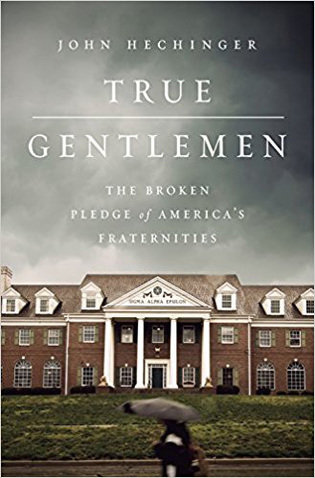 loading
loading
Reviews: November/December 2017 View full imageTrue Gentlemen: The Broken Pledge of America’s Fraternities Alex Beam ’75 is author of The Feud: Vladimir Nabokov, Edmund Wilson, and the End of a Beautiful Friendship.
This is an unusually good book about an unusual subject: college fraternities. The world more or less divides into people for whom “Greek life” is, well, Greek, and everybody else. I am one of the former, but there are plenty of the latter, e.g., the almost 400,000 undergraduates who are currently members of fraternities. Perhaps best known as centers of campus revelry—and worse—frats and sororities are also superb networking organizations that claim an elite membership: one third of the Supreme Court justices, almost two fifths of the Senate, and more than 15 presidents. That of course includes George H. W. Bush ’48 and his son George W. ’68, both well-known members of the Yale chapter of Delta Kappa Epsilon, or DKE. Hechinger focuses his book on SAE, Sigma Alpha Epsilon, which claims to be the largest US fraternity by aggregate membership. First established at the University of Alabama in 1856, SAE has been in the news of late, for all the wrong reasons. The fraternity has been implicated in four alcohol-related deaths since 2009; its misogyny is so legendary that some undergraduates suggest SAE stands for “Sexual Assault Expected.” SAE made national headlines (yet again) in 2015, when members were caught on video singing a racist song that had been making the rounds of various chapters. The chorus “There will never be a n-----r in SAE” was not only vulgar but, basically, true. Until recently, SAE has remained lily-white. The book’s title, True Gentlemen, comes from the SAE creed (“The True Gentleman is the man whose conduct proceeds from good will. . . .”), which, Hechinger argues, has been more honored in the breach than in the observance. He includes some fascinating, and hair-raising, history of SAE—although he also cites many examples of the fraternity’s charitable works and successful character-building interventions in the lives of the young men who pledged over the years. Hechinger, a much-decorated journalist for the Wall Street Journal and Bloomberg News, isn’t practicing “advocacy journalism”; he lets his reporting tell the story. After facing charges of hazing and serving drinks to minors at the University of North Carolina, one SAE member complained to the author that SAE was being victimized: “The chess club doesn’t have to go to sexual assault training.” After reading this excellent book, you will understand why no one confuses SAE with the chess club.
|
|